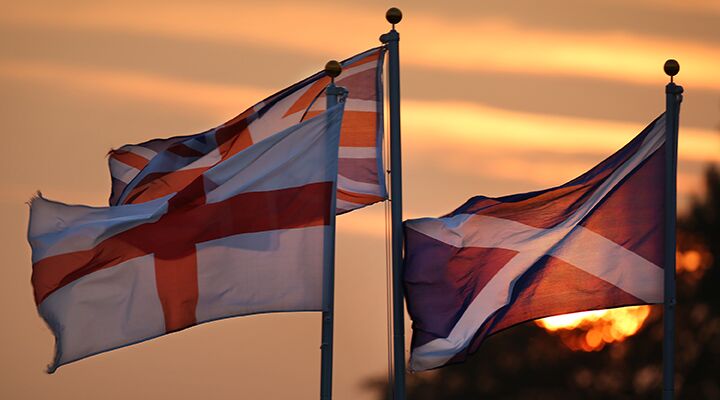
Scottish Independence: End of the World’s Most Unique Flag?
The people of Scotland will vote tomorrow on whether or not their nation should become an independent country—and leave the United Kingdom forever. Regardless of the outcome, the looming vote reveals how divided and weak the UK is today. The kingdom is not united. Britain, no longer “Great,” may soon become “Little Britain.”
One likely consequence of Scottish independence has not received much attention as of yet, but surely will if Scotland votes yes. If Scotland becomes independent, there is no logical or symbolic reason for using the Union Jack . (The Union Jack, flag of the United Kingdom, is a combination of the flags of England, Scotland and Northern Ireland.) It would be a similar scenario if the United States decided to return Alaska to Russia—there would be no logical or symbolic reason for the American flag to have 50 stars if the U.S. contracted to 49 states.
If the Union Jack becomes obsolete, such a development could have a domino effect on the flags of Commonwealth nations such as Australia, New Zealand and Fiji, which all have the Union Jack incorporated into their design. This could force them to change their flags.
The most important question to ask in all of this is, does the loss of the Union Jack carry any significance? If so, why?
The answer is yes. The reason is that the Union Jack actually tells a largely unknown story that dates back some 2,500 years.
In his book, Mr. Armstrong wrote:
[T]hat throne was divinely commissioned to be planted and rebuilt by the Prophet Jeremiah—during his lifetime! Jeremiah was set over both Judah and Israel. To be used in rooting out David’s throne in Judah. But more! To plant and to build, then, of necessity, among the house of Israel ….
[T]his same dynasty continued unbroken through all the kings of Ireland; was overturned and transplanted again in Scotland; again overturned and moved to London, England, where this same dynasty continues today in the reign of Queen Elizabeth ii.
The overturns he referred to can be found in Ezekiel 21:27, where God prophesied that David’s throne would be overturned three times. As Mr. Armstrong explains, God used Jeremiah to perform the first overturn, transporting both a stone (known as Jacob’s pillar stone, or the stone of destiny) and daughters of the king of Judah (see Jeremiah 40:6; 41:10) to Ireland around 569 b.c.
The high kings of Ireland, descendents of David’s line following the arrival of Jeremiah, were crowned over the pillar stone. Centuries later, David’s throne (his line and the stone) was overturned to Scotland, and that country’s kings were crowned over this stone. Finally, David’s throne was overturned to England—the stone in 1296 by Edward i, and David’s line via James vi of Scotland in 1603, becoming James i of England. Every subsequent monarch has been crowned over this stone.
Here is where the significance of the Union Jack becomes plain. Although Scotland and England did not enter a formal union until 1707, when the thrones of those kingdoms united in 1603, it gave impetus to the creation of a flag to represent this unification. The solution: Combine the St. George’s Cross on England’s flag with the St. Andrew’s Cross on Scotland’s flag. And so in 1606, what later became known as the Union Jack was born. Although the king of England also ruled Ireland at the time, it wasn’t until 1801 that the St. Patrick’s Cross of Ireland was incorporated into the flag as well, creating the version we are familiar with today. (It should be noted that the Republic of Ireland wasn’t formed until 1921.)
Since its inception, the Union Jack has told this amazing story. During the heyday of the British Empire, it told this story to the world.
No other flag has such meaning. Norway’s flag doesn’t have this special history nor tell this story; neither does Germany’s, or France’s, or even America’s. Only Britain’s.
It is this history—this story—that makes the Union Jack the most unique national flag in the world.
If Scotland votes for independence, it would likely mean the end of the Union Jack—the symbol of the illustrious, exciting, historical fulfillment of the prophesied three overturns of David’s throne.
